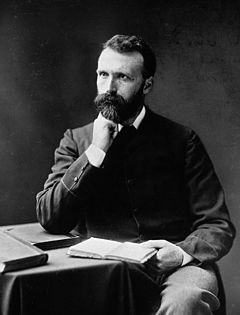William Macewen
Sir William Macewen CB , FRS , (born June 22, 1848 in Rothesay (Scotland) , Isle of Bute , † March 22, 1924 in Glasgow ) was a Scottish surgeon.
Life
Macewen graduated from the University of Glasgow with a Bachelor of Medicine (MB) and Master of Surgery (CM) degree in 1869 and an MD degree in 1872. He became a surgeon at the Western Infirmary in 1873, Assistant Surgeon in 1875, and in 1877 Surgeon at the Royal Infirmary in Glasgow. There he also held lectures from 1881 to 1889 and, after taking over the professorship, became a surgeon at the Western Infirmary in Glasgow and from 1883 at the Royal Hospital for Sick Children. In 1892 he became Regius Professor of Surgery in Glasgow. He later lived in Garrochty on the Isle of Bute.
plant
Macewen was a student of Joseph Lister in Glasgow , whose antiseptic techniques he systematically expanded and introduced corresponding strictly adhered to sequences of actions and procedures in the operating room (thorough hand washing before the operation, sterilization of instruments, sterile clothing, etc.). He is known for many innovations in surgery.
He was a pioneer in brain surgery and, building on the work of John Hughlings Jackson and David Ferrier on the localization of functions in the cerebral cortex, showed that this can be used to determine the location of tumors (1876). In 1876 he treated a boy with an abscess in the brain, but was not allowed to operate and could not prevent his death. From 1879 he undertook brain operations on patients with abscesses in the brain. He carried out the first successful operation on the brain in which a tumor ( meningioma ) was removed that had previously only been localized on the basis of epileptic symptoms. The patient survived another eight years and no new tumor was found on autopsy. Many other successful operations on abscesses and hematomas in the brain and spine followed, such as the first laminectomy for a spinal fracture in 1886. He published an anatomical atlas of the skull and was considered a specialist in the surgical treatment of inflammatory diseases of the temporal bone ( there the Foveola Suprameatica is also called Macewen's Triangle in English) and he also experimentally investigated bone growth and the healing of bone wounds in animals. The diagnosis of the location of abscesses and hydrocephalus in the brain by tapping the skull was also named after him in English (Macewen's Sign).
His pioneering contributions to orthopedics include the first successful allogeneic bone transplant (for the restoration of a humerus in 1881) and knee operations with the osteotome he developed and named after him . Both of these were used extensively for the common bone deformations due to vitamin D deficiency ( rickets ) by Macewen.
He developed a surgical method to remove a lung that he used on patients with lung cancer and tuberculosis.
Macewen also developed a surgical procedure for treating an inguinal hernia . He also promoted the developments in anesthesia , the use of the endotracheal tube inserted through the mouth in anesthesia goes back to him . He was a pioneer in the use of photographs in surgery and pathology for documentation and teaching purposes.
During World War I he was one of the founders of the Princess Louise Scottish Hospital for Limbless Sailors and Soldiers in Erskine , was its chief surgeon and also set up a prosthesis workshop , where he developed a prosthesis with the help of engineers from the nearby shipyards on the Clyde (river) ( Erskine Artificial Limb).
Honors
In 1922 he was President of the British Medical Association. In 1923 he headed the International Surgical Congress in London as President. In 1902 he was made a Knight Bachelor . In 1917 he became Companion of the Order of the Bath . He was a Fellow of the Royal Society (1895) and an Honorary Fellow of the Royal College of Surgeons of England (1900) and the Royal College of Physicians and Surgeons of Glasgow (1874). He has received honorary doctorates from Glasgow (LLD), Liverpool (LLD), Oxford (DSc) and Trinity College in Dublin (DSc).
Fonts
- Infectious purulent diseases of the brain and spinal cord: meningitis, brain abscess, infectious sinus thrombosis , Wiesbaden, J. Bergmann 1898
- The growth and shedding of the antlers of the deer; the histological phenomena and their relation to the growth of bone , Glasgow 1920
literature
- AK Bowman: Sir William Macewen , London, 1942
- HC Cameron: Reminiscences of Lister and of his work in the wards of the Glasgow Royal Infirmary , Glasgow, 1927
- Charles Duguid: Macewen of Glasgow: a recollection of the chief , Edinburgh, 1957
- J. Jenkinson, M. Moss, I. Russell: The Royal - The History of the Glasgow Royal Infirmary, 1794-1994 , Glasgow, 1994
- HA Macewen: The Man in the White Coat , Glasgow 1974
Web links
- SIR WILLIAM MACEWEN, CB, MD, FRCS, FRS In: Br Med J. 1924 Mar 29; 1 (3300): 603-608. PMC 2304086 (free full text)
- University of Glasgow website
Individual evidence
- ↑ a b c d e f g h i j k Papers of Sir William Macewen, 1848-1924, surgeon, Regius Professor of Surgery, University of Glasgow, Scotland, 1892-1924 at https://archiveshub.jisc.ac.uk ; accessed on November 30, 2017.
- ↑ Heinrich Broerken: About War spinal cord injuries. Univ.-Diss. Berlin, 1920
- ^ William Macewen (1921) The Growth and Shedding of the Antler of the Deer .
| personal data | |
|---|---|
| SURNAME | Macewen, William |
| BRIEF DESCRIPTION | Scottish surgeon |
| DATE OF BIRTH | June 22, 1848 |
| PLACE OF BIRTH | Rothesay (Scotland) , Isle of Bute |
| DATE OF DEATH | March 22, 1924 |
| Place of death | Glasgow |
